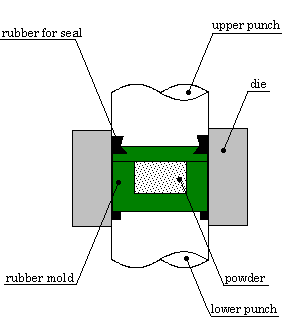|
|
|
| MAGNETIC ALIGHMENT EQUIPMENT |
| RIP as a powder compaction technique |
|
The rubber isostatic pressing (RIP) method
is originally developed by lntermetallics
Co., Ltd. for use with permanent magnet
powders. Now RIP is widening its applications for
use with growing number of materials
including
titanium alloys, cemented carbide,
ceramics
and diamond powders.
RIP is a pressing technology combining merits
of both die pressing and cold isostatic
pressing
(CIP) and we believe it can provide
the best-cost
performance. The advantages of RIP are flexibility in the shape and size of compacts,
no friction between the powder and the die wall cheaper tooling and the
elimination of contamination from binders and lubricants.
|
The principles of RIP are shown in Figure1.
A rubber mold with a cavity filled with powder
is inserted into a die. Then the powder filled
rubber mold is pressed by the upper and lower
punches to form a compact. In RIP, the powder is pressed not only along the press axis, but also in all lateral
directions due to the deformation@of the rubber mold.
|

Figure 1:RIP principles |

|
|
The most difficulty we dealt with in the
course of development of RIP was powder filling.
After several yearsf exploration, we developed
the air tapping (AT) method by which the
problems have been overcome. The air tapping
method enabled us to achieve high and homogeneous
filling of powder in the cavity of the rubber
mold. The method begins with a weighed powder
being poured into the hopper, which is then
covered. Then by driving the aspirator, air
in the hopper and the cavity is evacuated
which is followed by rapid introduction of
air into the hopper and the cavity. This air evacuation and introduction cycle
is repeated several times. This cycle acts
to destroy bridges and cavities contained
in the powder, as well as pushing the powder
toward the bottom of the rubber mold cavity
At the end of the filling process, which
takes a couple of seconds, the apparent density
of the powder reaches its tap density or
even higher.
|
|
NDK has already built some automated RIP systems,ten of which have been employed to produce green compacts for NdFeB permanent
magnets, andtwo to produce titanium and ceramics parts. The units typically comprise at
least four stations ---filling, pressing, ejecting and cleaning station---
with a corresponding number of rubber molds rotating between each
of them on an indexed turn table.
|

Figure 2:Automated RIP machine
|

Figure 3:Linear type RIP machine |
The turntable arrangement is not only increases the productivity of the
RIP machines, but also allows for a variety of other processing@operations to incorporated. An important example of this is magnetic alignment,
which is used when producing an isotropic NdFeB and ferrite sintered magnets.
Figure2 shows an example of an automated RIP machine that has six stations,
with an alignment station and additional cleaning station, and Figure3
shows a linear type RIP machine with five stations for producing@powder compacts of titanium alloys and ceramics. |
|
Advantages of RIP compared with CIP, MIM@(Metal Injection Molding)
|
| Flexibility in shape and size |
|
One of the important advantages of RIP is
flexibility in shape and size of the
compacts:
complex 3D - shapes and long tubes
as shown
in Figure4 can be produced.
|
| Tolerance |
|
The development of the air tapping method
has enabled the products to have tolerances
of 0. 5%. This is superior to CIP and
also to die pressing for some shapes, such
as long tubes.
|
| Productivity |
|
The fastest automated RIP press can produce a compact every 7 seconds, much faster than either CIP or MIM. In addition, it is very easy for RIP to employ a rubber mold with several
cavities so that several numbers of compacts are produced at the sametime,
which increases the productivity proportionally to this number.
|
| Homogeneity |
|
Because RIP can use powders without granulation, the compact has homogeneous
density distribution without suffering from defects such as large pores
resulted from the granulation process, which leads to good quality of the
sintered compacts.
|
| Powder Type |
|
RIP can use powders with average particle
sizes ranging from nanometers to several
tens of microns. Additionally, as the process does not create
any friction between the die wall and the
powder, RIP can press even such powders as
titanium al1oy powders and abrasive powders
including powders containing diamond powder
that have been difficult to process by die
pressing. Another advantage of RIP is the elimination
of potential for carbon contamination, because
RIP does not use binders nor lubricants.
|
| Cheaper Mold Cost and Rapid Sampling |
|
The RIP rubber mold is manufactured by casting liquid rubber into the master
mold produced by the simple machining of cheap materials like brass or
plastic. Because of this, the cost and lead times
for molds are very favorable compared with
other compaction techniques. The RIP presses can be smaller and less expensive than those for die pressing,
because requirements for accuracy is less in the RIP press than the die
pressing..
|
| Starting from magnetic materials, RIP is
broadening its applications to encompass
a wide range of metal powders and ceramic
powders. RIP is a very promising technology for production
of sinter parts made from titanium alloys,
cemented carbide, and diamond tools that
will benefit from the reduction in friction
and elimination of binders and lubricants,
as well as parts with geometries, such as
long and narrow shapes, that are difficult
to produce with die pressing. |
@@@@vv@@@@@@@@@@@@@@
|
|